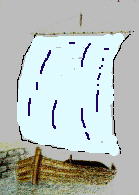George Templer secured a contract to supply granite for the rebuilding
of London Bridge (re-built in 1825) or at least he had been given the nod
that he would supply granite. It appears that this was the catalyst needed
for the construction of the tramway which was opened on 16th September
1820. Press reports from the time mention great rejoicing with large numbers
of people meeting in Bovey Tracey. George Templer addressed the crowds
and highlighted the benefits which the scheme would bring to the local
economy.
Although the tramway was a success, granite being supplied for London
Bridge, parts of the British Museum, the National Gallery, the Old General
Post Office, and the Waltham Monument (Ludgate Circus) it evenually proved
to be an expensive form of transportation. The granite blocks had to be
loaded and unloaded at least 3 times on route, firstly loaded at the quarry
face, then transferred to the barges at Ventiford and then transferred
from barge to ship at Teignmouth. The line consisted of a single almost
standard gauge track and was seven to eight and a half miles in length
falling over 1300 ft in its descent from the moor.
